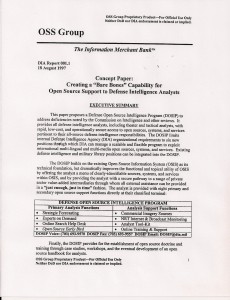
DOC: Creating a Bare Bones OSINT Capability
When Paul Wallner, on rotation from DIA to CIA, first attempted to establiksh an Open Source Intelligence (OSINT) concept of operations, this was the first paper delivered to him. At the same time, he gave OSS a fair shot at business with ten trial weekly reports spanning everything from medical to regions to logistics. What we did not discover until a few years ago is that a sergeant, then on reserve duty and billing himself as an OSINT expert, was throwing away our analytic summaries and loading the carefully sorted headines associated with each analytic summary into the DIA “bin” willy-nilly. Our attempt to show DIA that OSINT could be done as a low-cost out-sourced activity that did not require legions of contractors or “butts in seats,” died from this one specific pattern of misbehavior, a lack of intelligence and integrity on the part of one individual so shocking as to defy understuanding. Neither Wallner nor Steele knew about this until years later.
Today “everyone has an OSINT cell” but there is no enterprise. What is needed is an OSINT Center co-equal to the HUMINT/CI Center, with its own two-star commander, both reporting to the same three-star. The OSINT Center should be a hub for a global grid that includes regional multinational information-sharing and sense-making activities that work predominantly at the unclassified level, and should include a massive processing center that exchanges real-time sense-making back out to all who provide data into the processing center at machine speed–the United Nations and the International Committee of the Red Cross, among others, would be immediately attractive allies.
OSINT is the primary means of achieving a “shared view of the battlefield” in operations other than war (OOTW), in stabilization and reconstruction operations, in humanitarian assistance operations, and in disaster relief operations.
OSINT should also be the foundation for both the defense Quadrennial Defense Review (QDR) and the twin pillars of future integrated strategy,Whole of Government Planning, Programming, and Budgeting System WoG PPBS), and Multinational Peace & Prosperity Operations (MPPO) that leverage M4IS2 (Mutlinational, Multiagency, Multidisciplinary, Multipomain Information-Sharing and Sense-Making).

Click on the frog to read the 1996 piece on “Information Peacekeeping: Innovative Policy Options.” It is needed by the Secretary of Defense right now–today.



